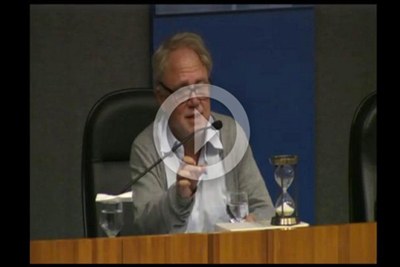The Relationship between Consciousness of Self and Perception of Time
What is the relationship between discerning the consciousness of self – in the sense of an individual’s apprehension of his own existence – and the perception of time? Psychoanalyst Leopold Nosek devoted his conference on April 25 at the Intercontinental Academia to an analysis of this matter.
He said that, given the fact that consciousness of self includes temporality and that humanization presupposes perception of time, one cannot but wonder how time presents itself to, and is perceived by, human beings.
In his reasoning, Nosek made use of analogies with works by “two writers who addressed the relativity of time from within the rationalist tradition:” The Magic Mountain (1924) and Doctor Faustus (1947), both by German-born Thomas Mann (1875-1955); and The Leopard (1958), by Italian author Tomasi di Lampedusa (1896-1957).
In the passage from The Magic Mountain quoted by Nosek, Hans Castorp, the main character, has just reached the conclusion that, for the mind, time does not flow uniformly; the mind only assumes it does so to maintain the proper order of things. Therefore, all measurements of time are no more than conventions.
According to Nosek, time and consciousness of self are contemporary themes. He mentioned Freud’s The Interpretation of Dreams (1900) as one of the landmarks, from the viewpoint of perception, for most texts that discuss Modernity.
He said that in this work by Freud one can see the loss of our naïve trust in the conscious mind and the inexorable breach between the conscious and the unconscious. For Nosek, we could speak of Modernity as the awareness of disruption.
 Addressing the emergence of this disruption, Nosek said we must remember how brief the Renaissance actually was, “with its glorious view of the individual as part of circumstances over which he had control.” However, it did not take long for Mannerism to come about, “with its distorted figures, its suffering subjectivity.”
Addressing the emergence of this disruption, Nosek said we must remember how brief the Renaissance actually was, “with its glorious view of the individual as part of circumstances over which he had control.” However, it did not take long for Mannerism to come about, “with its distorted figures, its suffering subjectivity.”
He said that art historian Arnold Hauser (1992-1978) saw Mannerism as the onset of the perception of modern man, “the perception of a shattered unity, of a broken harmony.”
As for The Leopard, Nosek noted that the novel is set in the mid-19th century, the time of Italy’s reunification and modernization. The main character, Don Fabrizio, prince of Salina, after a dance, realizes that he, unlike others, captures the passage of time, which is accompanied by “progress, destruction of old structures, creation of new wealth and new desolations.”
According to Nosek, “the prince of Salina, in a sudden glimmer of his own skin, grasps his circumstances, his historical destiny and his subjective self; his own place is revealed to him. What more could he obtain?”
For Nosek, grappling one’s circumstances and one’s time blends in with the apprehension of the limits and the space of human existence: “We continue, therefore, within our theme: the interconnection between the consciousness of self, the awareness of one’s ‘proper place,’ and the image of time defined by frustration and limitation.”
Related materialRelated new: |
|---|
In Doctor Faustus, the main character, the musician Adrian Leverkühn, makes a pact with the devil, Mephistopheles, giving his soul in exchange for 24 years of genius as a composer. Nosek noted how Mephistopheles warns the musician to pay attention to the hourglass.
For Nosek, Mephistopheles’ warning means Leverkühn should remain aware of life. As a result of the pact, Lerverkühn becomes part of Modernity, “through atonal spaces, the spatial expansion of musical contradiction, accompanied by scientific inquiries and by the theory of uncertainty and chance.”
He finished his presentation with some propositions by psychoanalyst Donald Meltzer (1922-2004) in his book Explorations in Autism (1975), where he organizes the space of life in a “geography of fantasy" that moves along in time.
According to Meltzer, experienced time can be a cloister where events are not available to memory and to thought (as happens in autism); it can be circular, undeveloping, where there is no death; or it can be oscillating, moving from within to outside the object and vice-versa, a continuous operation of omnipotence that makes the differentiation of self from object reversible, and also makes the direction of time itself reversible.
According to Nosek, remaining unidirectional and linear, from birth to death, requires a painful process, never completed, of renouncing the fusion between the self and the object, of struggling against narcissism, of assuaging omnipotence.

